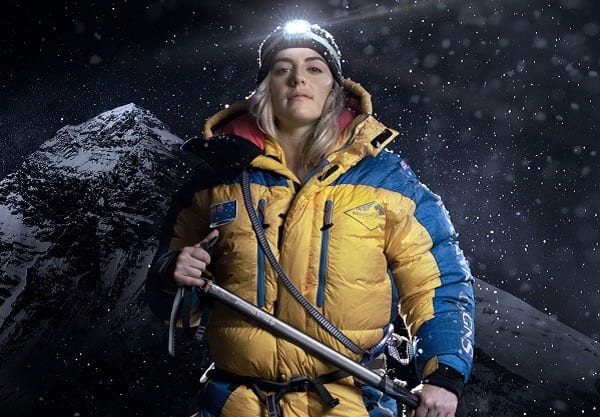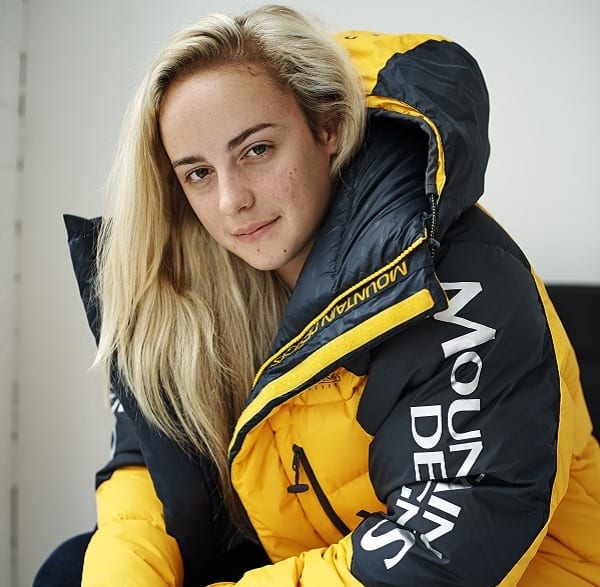Now 22, she is a Mountain Designs Ambassador and is continuing to push herself to new heights. Mountain Designs is an iconic Australian adventure brand that supports Alyssa on her adventures around the world.
On making it to the top of Everest, she says the biggest challenge was mental. While the physical aspects are an important part of the process, developing her mental ability to cope with suffering and manage pain, especially in the face of adversity, took four years to master.
“I needed to back myself and believe in myself even in the face of risk, danger and adversity,” she told Women’s Agenda recently.
She’s loved adventuring her entire life. She crossed the Kokoda Track with her father at just 8 years old and has no plans of slowing down.
Below, Azar tells Women’s Agenda about the thrill of adventure, what it takes to summit Everest and setting her sights on Russia’s highest mountain.
A couple of years ago, you became the youngest Australian to summit Mt Everest. Congratulations! Can you take us through the mindset you needed to achieve such a physically and mentally challenging feat?
Thanks! The mental aspect of climbing Everest was the biggest challenge.
Whilst I was physically preparing for years you also have to prepare your mind to have the ability to suffer and manage pain. I did a few training camps designed by ex-SAS soldiers in Perth which were there to test my commitment and how hard I was willing to push.
The biggest challenges on Everest are being able to perform despite the fact that up higher on the mountain you aren’t getting much oxygen and struggle to eat or sleep properly and still need to be able to climb through tough sections for 7, 8 or even up to 18 hours at a time.
I needed to back myself and believe in myself even in the face of risk, danger and adversity and be willing to work at my absolute limit for extended periods of time and work my through that.
It was roughly a four year process just to be ready for that expedition.
What initially sparked your interest in trekking, mountaineering and adventuring?
My Dad happened to be a guide on the Kokoda Track when I was really young. Around the age of 5, I began joining in on the weekend bush walks he would do with his clients to train them up for a trek. I loved it straight away and got addicted to the feeling of adventure and also getting to push myself mentally and physically. I would also hear different stories and experiences he had on the Track and I knew I wanted to do it someday.
I harassed him about it for a few years and when I was 8, he ended up letting me go to cross the Kokoda Track with him. It was incredibly challenging but I spent a year training for it and loved it. From then on I was hooked on it and every few years we would try to take on another trek somewhere.
Then, when I was 14, I personally wanted to take it to another level and wanted to get into climbing mountains.
You’ve taken on some of the toughest treks in the world and more recently high-altitude mountaineering expeditions. What do you value most about these sorts of challenges?
There’s a few reasons I value these challenges. I grow so much in such a short period of time and I think that process of performing at my best is very addictive. Once you see what you’re truly capable of, it is eye-opening.
I think I also do it for the simplicity and sense of calm and belonging that I feel in the mountains. Especially at high altitude, I strangely feel very at home and in my element.
What role does goal setting play in successfully completely major treks and/or climbs such as Mount Everest?
Goal setting is a huge part of trekking and climbing and I’ve always set goals for myself. It’s important, particularly with something like Mt Everest because there are so many factors and if you aren’t setting goals and holding yourself accountable you won’t be moving in the right direction to achieve your objective.
I try to keep it simple with three stages. I usually start by setting a bigger goal/vision for the next couple of years. I will then reverse engineer from that and set my mid-term goals that will help me get to my bigger ones. Breaking it down into smaller, more manageable goals makes it easier. Then I set my daily/weekly/monthly goals as well as routine and habits I’ll need to have in order to get to my bigger goals.
What advice would you give to other young people looking to step into the world of trekking and climbing?
Start wherever you can! Often these big expeditions and trips seem so far away but it happens through consistently building up your strength and your skills. Start with weekend treks and adventures and see where it takes you.
Can you tell us a little about any of the upcoming adventures you have planned, including your next climb?
I have three adventures on this year. My next climb is in Russia and is less than four weeks away. I’m actually guiding a group of Australians on a climb to summit the highest mountain in Russia – Mt. Elbrus.
Then, in October I’ll be guiding a group on the Aussie 10 Peaks (the 10 highest peaks in Australia all based in Kosciuszko National Park) It’s only two days of trekking but very challenging with a 14-hour day on the first day and a fair bit of distance to cover. They aren’t technical peaks but you never know what the weather will do.
At the end of this year I will head back to South America for three weeks to guide a climb in the Andes on Mt. Aconcagua.




